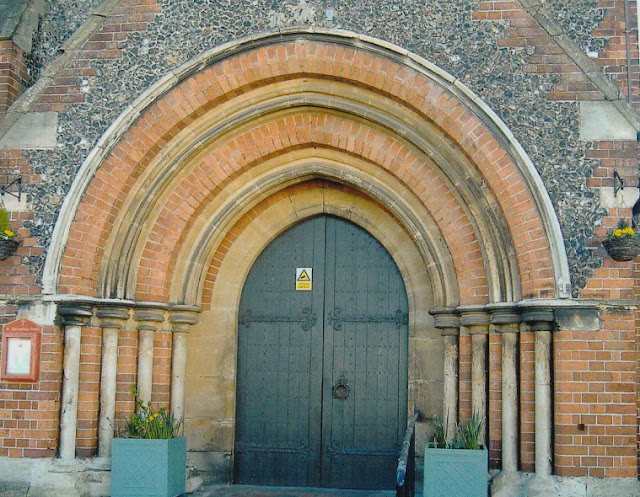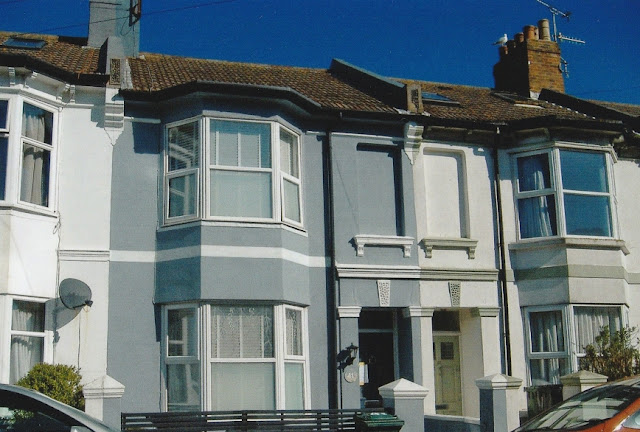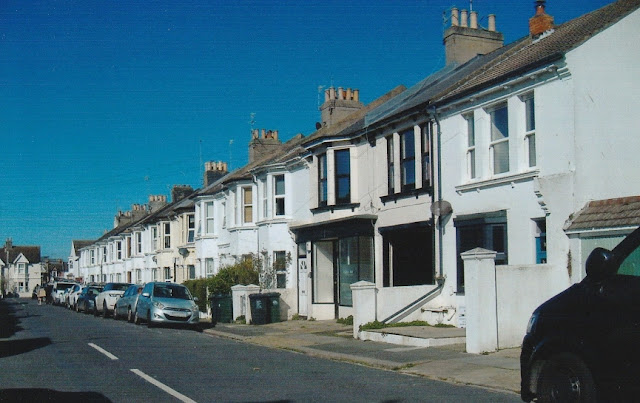Judy Middleton 2002 (revised 2023)
 |
| copyright © J.Middleton The east end of Coleridge Street photographed in March 2022 |
The street was named after the poet Samuel Taylor Coleridge (1771-1834) and two of his most famous poems are The Rime of the Ancient Mariner and Kubla Khan. He became firm friends with William Wordsworth who also has a street named after him in the area known as Poets’ Corner in Hove.
This land once formed part of the Vallance Estate, and since Thomas Lainson was surveyor to this estate, he also had a hand in the development of this street, in the general layout and many of the houses.
Although planning permission was granted in 1881, building work did not get under way until the 1890s, and the entry in the Directory for 1892 states ‘Houses building’. It is interesting to note that the original Coleridge Street stretched to the old Hove Parish boundary, and when Aldrington was amalgamated with Hove, it was decided to extend the street across the border, and consequently in 1895 it was decided that a re-numbering was necessary.
In 1897 Coleridge Street, from the west side of Sackville Road to the east side of Westbourne Street, was declared a public highway. But the rest of it, from the west side of Westbourne Street to the east side of Rutland Road, had to wait until 1902 before it followed suit.
St Barnabas Church
 |
| copyright © J.Middleton The doorway into St Barnabas Church from Coleridge Street |
The Ancient Mariner
 |
| copyright © J.Middleton The Ancient Mariner |
Although this pub is officially located at 59 Rutland Road, it has a north frontage to Coleridge Street. It started off being called The Rutland. (For further details please see under The Ancient Mariner.)
Coleridge Street Roman Catholic School
See the separate page for the Coleridge Street Roman Catholic School
House Notes
 |
| copyright ©
Royal Pavilion & Museums, Brighton & Hove Brighton Herald 30 March 1912 |
Number 1 – In 1901 Oliver Bungard, a mason lived here. By 1914 the Misses Hillman ran a draper’s shop on the premises. By 1920 they were still in business but had re-branded their business description to ‘fancy depository’. By 1937 it had reverted to being an ordinary draper’s and it was run by the Misses A. B. Reane.
Number
6
- In 1901 Noah Wright, a watchmaker, lived here.
Number
9
– Professional footballer Bob Whiting lived in this house with his
wife and two children. He was born at West Ham on 6 January 1883, and
the Sussex
Daily News
described him as one who ‘greatly distinguished himself as
goalkeeper in the service of Brighton & Hove Albion, and
previously at Chelsea.’
 |
| copyright ©
Royal Pavilion & Museums, Brighton & Hove
Hand-tinted picture postcard of the Brighton &
Hove Albion Football Club, 1908-1909. Bob Whiting is in the back row the second from the left |
Whiting joined the ‘Sportsmen’s Battalion’ Middlesex Regiment on 1 January 1915. He was sent over to France and was killed in action on 28 April 1917. When he died, there was a three-month old baby at home whom he never saw. Perhaps it was his sad widow who, when the Hove War Memorial at Grand Avenue was unveiled, laid a small bunch of violets with the heart-breaking message ‘From the little baby who he never saw’.
Number 19 – In 1920 George Gavett lived in this house and earned his living as a gardener.
Number 20 – In 1901 F. W. Cecil, a tailor, lived in this house.
Number 23 – The Polish Daily was printed in these premises from 1940. During its heyday in the 1950s the paper sold around 50,000 copies daily and there was a workforce of 80 people. On 12 July 1990 the The Polish Daily celebrated its 50th birthday, but it was also a time of reflection because circulation numbers had fallen to 12,000.
The building was called Caldra House, and the managing director of Caldra publishing and printing company was Tadeusz Filipowiez-Phillips who joined the staff as a printer in 1962. It is sad to record that by the turn of the century the readership had fallen to 3,000 with the reader’s average age being 75; the number of staff had fallen drastically, and by then there were only eight people. In 2001 the freehold premises were on sale for £700,000. The last Hove copy of the newspaper rolled off the press in October 2001. But all was not lost for the faithful elderly readers because the money derived from the sale would allow the paper to be printed for another ten years in London.
Number 28 – This building had quite a long history as a tobacconist. In 1901 it was a tobacconist and confectioner run by W. John Boreham. By 1914 R. J. and C. Clement were running the business as just a tobacconist. In 1920 the Clements were still there, and the Directory kindly tells us it was two spinsters who were in charge.
Number
30
– In 1914 W. H. Townsend & Sons, occupied the premises. The
Townsend family were still in business there in 1937 under the banner
William Henry Townsend & Sons, dairy. Also living there was
Albert Edward Townsend.
 |
| copyright © J.Middleton Signalman Frederick George Victor Young lived in this house |
Number 41 – Signalman Frederick George Victor Young lived in this house and in August 1914 he joined the Royal Naval Reserve. He became ill with bronchitis and in January 1915 he was invalided out of service; it took him over three months to recover. When he was better, perhaps he decided that a life at sea was not for him, and in May 1915 he joined the Royal Flying Corps. He became a wireless operator, and saw service at the Battle of the Somme. Unhappily, he went down with pneumonia, and in March 1917 he had to be invalided out a second time. He was sent to Foredown Isolation Hospital, Portslade. He made a good recovery, and was all set for his discharge when he was felled by the Spanish flu, followed by another dose of pneumonia. He was aged 30 when he died on 23 October 1918.
 |
| copyright © G. Osborne With thanks to Mr G. Osborne for granting permission for the reproduction of the above photograph from his private collection. Foredown Isolation Hospital, Portslade |
Number 50 – In 1901 Frederick Hoare, a plumber, lived in this house.
Number 51 – In 1901 the Misses Field ran a general store here. But in 1914 Mr Walsh oversaw a newsagent’s instead. By 1920 Thomas William Dickerson’s shop was a confectioner’s and tobacconist’s, and he was still in business in 1937.
This house was also the home address of Joseph Card. When the First World War broke out, he lost no time in joining the armed forces, and enlisted in the Royal Navy on 18 August 1914. Able Seaman Card died on 13 July 1915, not in a sea battle, but at Gallipoli during the disastrous landings there. He was in Drake Battalion, one of the four battalions that composed the 63rd Royal Naval Division. This division was composed mostly of reservists or those not immediately required for service at sea.
Number 53 – In 1901 the premises were occupied by William George Wilsher, grocer. In the same year, he was also running a grocer’s shop in Byron Street, which was still going in 1921 and later on too, but he must have decided to relinquish the one in Coleridge Street because by 1920 Percy Weller was the grocer, and in 1937 it was still a grocery run by Arthur William Miller.
Number 55 – In 1901 A. Jewhurst ran a draper’s and stationery business here, a rather odd combination, but by 1914 he had gone. By 1920 Ernest Stacey had set up business as a boot repairer, and he was still there in 1937. Also in 1937 Alfred Corbin, a printer, was to be found at 55a.
Number 57 – In 1937 Edward J. Rooke, decorator, lived in this house.
Number 59 – In 1914 the Southdown Laundry was located here and it was still in business in 1937 being then the Southdown Laundry (Hove). It seemed the business managed to share their address with other people. For example, in 1914 A. E. Tully ran a confectioner’s at 59a, while in 1920 there was Charles Albert Foulser, a draper.
Number 61 – This house has been home to a variety of trades. In 1901 L. Hollands, a signwriter, lived here. By 1914, it was a fruiterer’s, and in 1937 it was a confectioner’s run by Edwin R. Wilson.
Number 63 – In 1901 John Allen ran a general store here, and he was still in business in 1914.
Number 68 – In 1920 Miss M. Long, dressmaker, lived in this house.
Number 80 – In 1901 Mrs Still earned a living as a laundress, and she was still taking in washing in 1920.
Number
82
– There was a laundress at number 80, and in 1901 there was a
similar business here. It was called rather grandly the London
Laundry. Clothes were still being washed on site in 1914 but it was a
Mrs Simms who was the laundress, and by 1920 it was Henry Simms who
was taking in laundry.
 |
| copyright ©
Royal Pavilion & Museums, Brighton & Hove Brighton Herald 26 November 1896 |
Number 86 – In 1937 R. B. Wray, an electrical engineer, lived here.
Number 87 – In 1920 David William Knight, window cleaner, lived here, and he was still in business in 1937.
Number 88 – In 1901 Austin Pyer, photographer, lived in this house. James William Harding ran a tobacconist’s here in 1937.
Number 89 – In 1901 H. Marsh, decorator, lived here.
Number 90 – By 1904 the Ellesmere Cleaning Company occupied the premises, and in 1904 applied for planning permission for a workshop at the rear; in 1914 P. Weller was the manager.
Number 91 – In 1901 Edward Waite, a builder, lived in this house.
Number
96
– In 1901 the Belmont Laundry was situated here while at 96a there
was the Hove Mineral Water Co.
 |
| copyright ©
Royal Pavilion & Museums, Brighton & Hove Brighton Herald 1 April 1911 |
Number 96a – In 1920 this was the home of the C. Hounslow & Company metal sheets works.
By 1928 the business was known as Hounslow’s Sheet Metal Works when on 4 September of that year a disastrous fire broke out. The Fire Brigade was alerted by a call from the St Barnabas fire-box at 8.41 a.m. followed by another call from the Rutland Gardens box one minute later. The fire began with startling suddenness when the foreman, Mr G. Phillimore, switched on the gas in the spraying room, and turned to light the machine. A second later he looked round and saw flames leaping up.
The newspaper report went as follows, ‘Two engines, four hydrants and three lines of hose were speedily set to work, yet despite this the firemen were unable to approach within 10-ft of the centre of the trouble for some time.’ The heat was so fierce that the iron girder supporting the ceiling began to sag considerably, which gave rise to fears that valuable machinery was about to come crashing down. Mr Hounslow, owner of the establishment, praised the exceptionally smart work of the brigade, while Chief Officer Dumbrell was pleased the fire had been subdued so quickly.
Number 98 – By 1920 the machine joinery works of Miles & Company was sited here, and it was still going in 1937.
Number 100 – By 1914 the West End Laundry was to be found here run by Mrs Denniston, and it was still there in 1920.
Number 102 – Henry Henty, decorator, lived here in 1937.
Number
106
– By 1901 the Rutland Sanitary Laundry was established in the
premises, and was still in business in 1914. By 1906 it was being run
by H. J. Rothery. Still keeping its rather grand name, it remained in
operation in 1937 when Mrs E, Westwood was in charge.
 |
| copyright © J.Middleton The west end of Coleridge Street |
Hove Planning Approvals
1881 – T. Lainson & Son, six houses on the south side
1892 – Carpet Beating Factory, house and stables in Coleridge Street and Sheridan Road
1893 – T. Lainson and Son for Mr Chadwell, six houses, and one house and shop
1893 – A. Lewis for H. F. Humphrey, one house, south side
1893 T. Lainson & Son for C. and W. Chadwell, four houses
1893 – T. Lainson & Son for Mr H. Chadwell, five houses
1893 – F. Waite, seven houses, one workshop, Upper Westbourne Street and Coleridge Street
1893 – H. Chadwell, six houses
1894 – T. Lainson & Son for H. Chadwell, three houses
1894 – T. Lainson & Son for Mr Chadwell, eight houses
1894 – T. Lainson & Son for Mr Cook, four houses
1894 – T. Lainson & Son for C. and W. Chadwell, six houses
1894 – T. Lainson & Son, four houses
1894 – T. Lainson & Son for Mr Chadwell, two houses
1894 – T. Lainson & Son for C. Smith, four houses
1894 – T. Lainson & Son for C. and W. Chadwell, three houses and shops, north side, corner of Sheridan Road
1894 – T. Mills, laundry and house, south side
1894 – C. and W. Chadwell, house with stable and workshop at rear, south side
1894 – T. Lainson & Son for Mr Taylor, five houses
1894 – C. Blandford, four houses, south side
1895 – C. A. S. Stuart, one house, south side
1895 – A. Tree for E. Waite, six houses, north side
1895 – A. Tree for E. A. Waite, one house and stable, north side
1895 – A. Tree for E. Waite, store at rear, north side
1895 – C. Blandford, workshops and stores, south side
1896 – H. V. C. Smith for E. Waite, one house and workshop, north side
1896 – C. Blandford, stables, coach house and workshops
1904 – S. M. Lampard for Ellesmere Cleaning Company, workshop at rear of number 90
1915 – Denman & Matthews for F. Winn, alterations and additions to factory at rear of number 96
Sources
Encyclopaedia of Hove and Portslade
Hove Council Minute Books
Middleton,
J. Hove
and Portslade in the Great War (2014)
Mr G Osborne
Royal Pavilion & Museums, Brighton & Hove
Street Directories
Copyright © J.Middleton 2022
page layout by D. Sharp